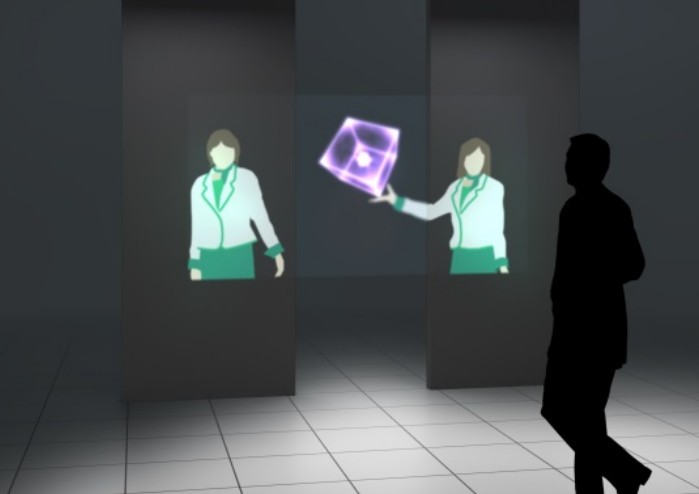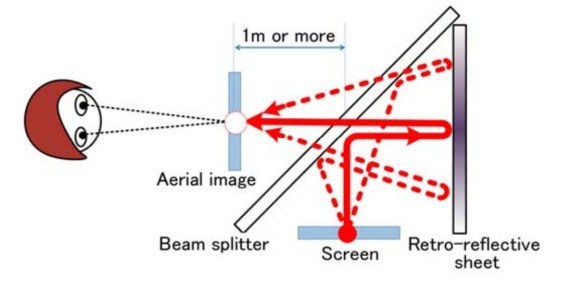
Mitsubishi says it’s coming close to perfecting the kind of floating “hologram” images seen in sci-fi films—and it hopes to introduce the “Aerial Display” technology in time for the 2020 Tokyo Olympics.
The “holographic” performances of fictional android singer Hatsune Miku might seem like an amazing feat of future technology, but look more closely (not that you’d want to) at Miku’s performances — or live shows by the equally fictitious Gorillaz, if that’s more your flavor — and you might notice that these so-called “holograms” are actually just computer generated images being projected onto a thin, transparent screen.
Actual holograms as they’re depicted in science fiction — images that are literally projected onto thin air — are still an out-of-reach, nerdy pipe dream. Or so we thought until Mitsubishi suddenly announced they’d pretty much created the real deal and are planning to spring it on the public at the 2020 Tokyo Olympics.
The tech is actually deceptively simple when you get down to it. At its core, Mitsubishi’s “Aerial Display” is, essentially, a set of mirrors that reflect a projected image into open space. That sounds decidedly low-tech, but don’t count on being able to reproduce the effect with your dad’s 70s-era slide projector and your bathroom mirror. The key component required to make the whole thing work is something called a beam splitter, which Mitsubishi describes as, “an optical device that divides incoming light into reflected light and transmitted light.” Additionally, a “retro-reflective sheet” is also required, but as far as we can tell, this is fancy science speak for, uh… a mirror (please direct geeky corrections to the comments section).
When these components work together, the result is a display that floats in mid-air, and Mitsubishi says the system is capable of projecting fairly large images — up to and possibly exceeding human size.
Surprisingly, Mitsubishi is just one of several companies around the world working on similar tech. There are other working prototypes out there, but a major problem with the tech has been that the images must be viewed from a particular angle to appear to the viewer as intended. It’s unclear if Mitsubishi’s crack at the whole hologram thing will rectify this problem, but we suppose we’ll find out officially when Mitsubishi inevitably displays an enormous holographic Gundam onto the field at the 2020 Olympic opening ceremony.
Source and Images: Mitsubishi


 Japanese toilets become even more high-tech with new floating panels
Japanese toilets become even more high-tech with new floating panels Amazing hologram-style Pokédex is waiting for fans to try at Tokyo’s new Pokémon megastore【Video】
Amazing hologram-style Pokédex is waiting for fans to try at Tokyo’s new Pokémon megastore【Video】 How to use the new floating hologram registers at 7-Eleven
How to use the new floating hologram registers at 7-Eleven Starbucks Japan ready to get Year of the Horse started with adorable drinkware and plushies【Pics】
Starbucks Japan ready to get Year of the Horse started with adorable drinkware and plushies【Pics】 We found possibly the quietest Japanese-style hotel in Tokyo’s bustling Shinjuku district
We found possibly the quietest Japanese-style hotel in Tokyo’s bustling Shinjuku district 7 great places to see Mt. Fuji from without having to climb it
7 great places to see Mt. Fuji from without having to climb it New Studio Ghibli collection includes a US$2,450 wooden Totoro 【Video】
New Studio Ghibli collection includes a US$2,450 wooden Totoro 【Video】 Kagawa Prefecture becoming Slowpoke Paradise this spring
Kagawa Prefecture becoming Slowpoke Paradise this spring Tokyo sex industry worker arrested for saying she needed tuition money, spending it on hosts
Tokyo sex industry worker arrested for saying she needed tuition money, spending it on hosts Sanrio theme park in Japan announces plans to expand into a Sanrio resort
Sanrio theme park in Japan announces plans to expand into a Sanrio resort The tragedy of Mononofu, the functional two-and-a-half-story bipedal robot【Pics & Video】
The tragedy of Mononofu, the functional two-and-a-half-story bipedal robot【Pics & Video】 The mystery destination of the SoraNews24 end-of-year party left us speechless
The mystery destination of the SoraNews24 end-of-year party left us speechless Shikadamari: The Nara deer summer gathering phenomenon that baffles visitors every year
Shikadamari: The Nara deer summer gathering phenomenon that baffles visitors every year Disillusionment at Tsukiji’s tourist-target prices led us to a great ramen restaurant in Tokyo
Disillusionment at Tsukiji’s tourist-target prices led us to a great ramen restaurant in Tokyo Japan may add Japanese language proficiency, lifestyle classes to permanent foreign resident requirements
Japan may add Japanese language proficiency, lifestyle classes to permanent foreign resident requirements Lacquerware supplier to emperor of Japan and Pokémon team up for new tableware
Lacquerware supplier to emperor of Japan and Pokémon team up for new tableware Starbucks Japan releases new zodiac chilled cup drink for 2026
Starbucks Japan releases new zodiac chilled cup drink for 2026 7-Eleven Japan’s ramen-cooking robot whipped us up a bowl of noodles【Taste test】
7-Eleven Japan’s ramen-cooking robot whipped us up a bowl of noodles【Taste test】 Cyberpunk anime meets traditional culture in Ghost in the Shell gold leaf Japanese changing screens
Cyberpunk anime meets traditional culture in Ghost in the Shell gold leaf Japanese changing screens Hello Kitty Choco Egg figures are an adorable trip through three periods of Japanese pop culture【Pics】
Hello Kitty Choco Egg figures are an adorable trip through three periods of Japanese pop culture【Pics】 Japan’s otoshidama tradition of giving kids money at New Year’s gets a social welfare upgrade
Japan’s otoshidama tradition of giving kids money at New Year’s gets a social welfare upgrade Japan’s human washing machines will go on sale to general public, demos to be held in Tokyo
Japan’s human washing machines will go on sale to general public, demos to be held in Tokyo 7-Eleven Japan starts new temporary luggage storage service in over 300 branches
7-Eleven Japan starts new temporary luggage storage service in over 300 branches Starbucks teams up with 166-year-old Kyoto doll maker for Year of the Horse decorations【Photos】
Starbucks teams up with 166-year-old Kyoto doll maker for Year of the Horse decorations【Photos】 Tokyo considering law requiring more trash cans following litter increase in heavily touristed area
Tokyo considering law requiring more trash cans following litter increase in heavily touristed area Tokyo’s Tsukiji sushi neighborhood asks tour groups to stay away for the rest of the month
Tokyo’s Tsukiji sushi neighborhood asks tour groups to stay away for the rest of the month Nintendo’s Kirby now delivering orders at Kura Sushi restaurants, but not in Japan
Nintendo’s Kirby now delivering orders at Kura Sushi restaurants, but not in Japan Tokyo event lets you travel back in time, for free, to celebrate 100 years since Showa era start
Tokyo event lets you travel back in time, for free, to celebrate 100 years since Showa era start Stamina-destroying “Paralysis Noodles” are Tokyo’s newest over-the-top ramen innovation
Stamina-destroying “Paralysis Noodles” are Tokyo’s newest over-the-top ramen innovation Survey asks foreign tourists what bothered them in Japan, more than half gave same answer
Survey asks foreign tourists what bothered them in Japan, more than half gave same answer Japan’s deadliest food claims more victims, but why do people keep eating it for New Year’s?
Japan’s deadliest food claims more victims, but why do people keep eating it for New Year’s? We deeply regret going into this tunnel on our walk in the mountains of Japan
We deeply regret going into this tunnel on our walk in the mountains of Japan Studio Ghibli releases Kodama forest spirits from Princess Mononoke to light up your home
Studio Ghibli releases Kodama forest spirits from Princess Mononoke to light up your home Major Japanese hotel chain says reservations via overseas booking sites may not be valid
Major Japanese hotel chain says reservations via overseas booking sites may not be valid Put sesame oil in your coffee? Japanese maker says it’s the best way to start your day【Taste test】
Put sesame oil in your coffee? Japanese maker says it’s the best way to start your day【Taste test】 No more using real katana for tourism activities, Japan’s National Police Agency says
No more using real katana for tourism activities, Japan’s National Police Agency says The top 10 annoying foreign tourist behaviors on trains, as chosen by Japanese people【Survey】
The top 10 annoying foreign tourist behaviors on trains, as chosen by Japanese people【Survey】 Starbucks Japan reveals new sakura drinkware collection, inspired by evening cherry blossoms
Starbucks Japan reveals new sakura drinkware collection, inspired by evening cherry blossoms
Leave a Reply